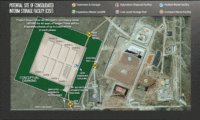
The future of new nuclear plant construction in the United States hinges upon the performance of The Shaw Group and partner Westinghouse Electric as they build the first new U.S. nuclear reactors in more than 20 years, speakers at the Nuclear Energy Insider Nuclear Construction Summit agreed at the event on Oct. 26 in Charlotte, N.C.
“Clarence and his team are make-or- break. If the team at Vogtle stumbles and falls, it is all over for us,” Bob Coward, principal at Alexandria, Va.-engineering firm MPR Inc., said of keynote speaker and CEO Clarence Ray Jr. and his Shaw Power Group team.
The Shaw Group and Westinghouse expect to begin building the first new nuclear units at Atlanta-based Southern Co.'s Vogtle plant, near Waynesboro, Ga., next year. While preconstruction work is employing about 1,700 on the site, the work on the nuclear portion of the two AP1000s cannot begin until after the Nuclear Regulatory Commission (NRC) issues a final construction and operating license, expected later this year or early next year. Soon after, Shaw and Westinghouse will begin work on two additional AP1000s at Cayce, S.C.-based SCANA Corp.'s V.C. Summer nuclear plant. The first 1,154-MW unit at Vogtle is scheduled to be in operation by 2016.
“It's critical that we get it right, and that boils down to Vogtle as we sit,” said Chris Tye, senior vice president for Irving, Texas-based Fluor Corp.'s nuclear group. The problems that occurred in the last round of new builds of nuclear reactors, such as cost overruns and schedule delays, “cannot be repeated, or we will not have a resurgence.”
In a later interview, Ray agreed with the assessment, saying, “They are exactly right. If we are not successful, it will set the industry back 10 years.”
Tye, however, said the industry is capable of finishing a plant on time and on budget. “It's basic blocking and tackling,” he said. “We know how to do that.”
So far, the biggest stumbling block for the industry has been finding qualified suppliers, several conference speakers said. Companies have to search around the world for nuclear-qualified suppliers. Then, in order to ensure nuclear-quality components, contractors and owners have to be “intrusive” in their suppliers business, said Ricardo Llovet, director of engineering and procurement for Westinghouse at Vogtle. “You have to assume the worst,” Llovet said. “You have to assume that suppliers are going to be late” and plan around projected delays.
Because of problems such as finding qualified suppliers, “it may not be such a bad thing that the [nuclear] renaissance didn't cascade down upon us,” Tye said.
While the nuclear industry previously expected a renaissance of nuclear new builds, with up to 20 new units by 2020, “time and the economy has tempered that enthusiasm,” said Laura Dudes, director of NRC's division of construction inspection and operational programs. The NRC still is actively working on 12 applications, but Duke Energy, for one, only expects about four to eight new reactors to be operational by 2020, said Ron Jones, senior vice president of nuclear development for Charlotte, N.C.-based Duke. Duke is taking its time to develop two AP1000s at the William States Lee III site in Cherokee County, S.C., because the recession has slowed demand for energy. Duke expects to pour the plant's first concrete in 2015.
Ray and others insisted the disaster at the Fukushima Daiichi nuclear plant has not slowed down development of nuclear power in the U.S. and said any slowdown is because of the economy and cheap natural-gas plants.
In fact, post-Fukushima, the departure of some countries from new nuclear development may have broken the logjam of back orders for large nuclear components and allowed other countries to move ahead, said Dan McGarvey, chairman of U.S. Power and the utility arm of Marsh USA, an insurance broker headquartered in Houston. According to a presentation on Tuesday by the consulting group Booz & Co., Washington, D.C., nuclear development has accelerated 23% in China and 14% in India since Fukushima.

